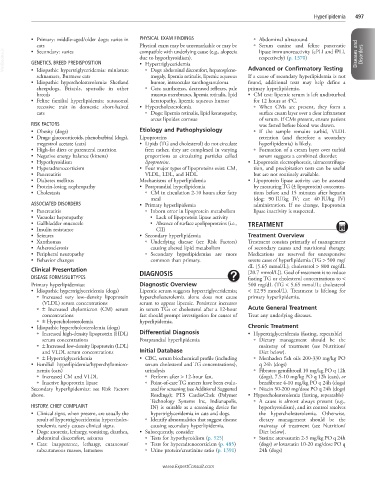Page 1012 - Cote clinical veterinary advisor dogs and cats 4th
P. 1012
Hyperlipidemia 497
• Primary: middle-aged/older dogs; varies in PHYSICAL EXAM FINDINGS ○ Abdominal ultrasound
cats Physical exam may be unremarkable or may be ○ Serum canine and feline pancreatic
VetBooks.ir GENETICS, BREED PREDISPOSITION due to hypothyroidism). Advanced or Confirmatory Testing Diseases and Disorders
compatible with underlying cause (e.g., alopecia
• Secondary: varies
lipase immunoreactivity (cPLI and fPLI,
respectively) (p. 1370)
• Hypertriglyceridemia
• Idiopathic hypertriglyceridemia: miniature
megaly, lipemia retinalis, lipemic aqueous
schnauzers, Burmese cats ○ Dogs: abdominal discomfort, hepatospleno- If a cause of secondary hyperlipidemia is not
• Idiopathic hypercholesterolemia: Shetland humor, intraocular xanthogranuloma found, additional tests may help define a
sheepdogs, Briards, sporadic in other ○ Cats: xanthomas, decreased reflexes, pale primary hyperlipidemia.
breeds mucous membranes, lipemia retinalis, lipid • CM test: lipemic serum is left undisturbed
• Feline familial hyperlipidemia: autosomal keratopathy, lipemic aqueous humor for 12 hours at 4°C.
recessive trait in domestic short-haired • Hypercholesterolemia ○ When CMs are present, they form a
cats ○ Dogs: lipemia retinalis, lipid keratopathy, surface cream layer over a clear infranatant
arcus lipoides corneae of serum. If CMs present, ensure patient
RISK FACTORS was fasted before blood was drawn.
• Obesity (dogs) Etiology and Pathophysiology ○ If the sample remains turbid, VLDL
• Drugs: glucocorticoids, phenobarbital (dogs), Lipoproteins retention (and therefore a secondary
megestrol acetate (cats) • Lipids (TG and cholesterol) do not circulate hyperlipidemia) is likely.
• High-fat diets or parenteral nutrition free; rather, they are complexed in varying ○ Formation of a cream layer over turbid
• Negative energy balance (kittens) proportions as circulating particles called serum suggests a combined disorder.
• Hypothyroidism lipoproteins. • Lipoprotein electrophoresis, ultracentrifuga-
• Hyperadrenocorticism • Four major types of lipoproteins exist: CM, tion, and precipitation tests can be useful
• Pancreatitis VLDL, LDL, and HDL. but are not routinely available.
• Diabetes mellitus Mechanisms of hyperlipidemia • Lipoprotein lipase activity can be assessed
• Protein-losing nephropathy • Postprandial hyperlipidemia by measuring TG (± lipoprotein) concentra-
• Cholestasis ○ CM in circulation 2-10 hours after fatty tions before and 15 minutes after heparin
meal (dog: 90 IU/kg IV; cat: 40 IU/kg IV)
ASSOCIATED DISORDERS • Primary hyperlipidemia administration. If no change, lipoprotein
• Pancreatitis ○ Inborn error in lipoprotein metabolism lipase inactivity is suspected.
• Vacuolar hepatopathy ■ Lack of lipoprotein lipase activity
• Gallbladder mucocele ■ Absence of surface apolipoproteins (i.e., TREATMENT
• Insulin resistance CII)
• Seizures • Secondary hyperlipidemia Treatment Overview
• Xanthomas ○ Underlying disease (see Risk Factors) Treatment consists primarily of management
• Atherosclerosis causing altered lipid metabolism of secondary causes and nutritional therapy.
• Peripheral neuropathy ○ Secondary hyperlipidemias are more Medications are reserved for unresponsive
• Behavior changes common than primary. severe cases of hyperlipidemia (TG > 500 mg/
dL [5.65 mmol/L]; cholesterol > 800 mg/dL
Clinical Presentation [20.7 mmol/L]). Goal of treatment is to reduce
DISEASE FORMS/SUBTYPES DIAGNOSIS fasting TG or cholesterol concentrations to <
Primary hyperlipidemias: Diagnostic Overview 500 mg/dL (TG < 5.65 mmol/L; cholesterol
• Idiopathic hypertriglyceridemia (dogs) Lipemic serum suggests hypertriglyceridemia; < 12.95 mmol/L). Treatment is lifelong for
○ Increased very low–density lipoprotein hypercholesterolemia alone does not cause primary hyperlipidemia.
(VLDL) serum concentrations serum to appear lipemic. Persistent increases
○ ± Increased chylomicron (CM) serum in serum TGs or cholesterol after a 12-hour Acute General Treatment
concentrations fast should prompt investigation for causes of Treat any underlying diseases.
○ ± Hypercholesterolemia hyperlipidemia.
• Idiopathic hypercholesterolemia (dogs) Chronic Treatment
○ Increased high-density lipoprotein (HDL) Differential Diagnosis • Hypertriglyceridemia (fasting, repeatable)
serum concentrations Postprandial hyperlipidemia ○ Dietary management should be the
○ ± Increased low-density lipoprotein (LDL) mainstay of treatment (see Nutrition/
and VLDL serum concentrations Initial Database Diet below).
○ ± Hypertriglyceridemia • CBC, serum biochemical profile (including ○ Menhaden fish oils 200-330 mg/kg PO
• Familial hyperlipidemia/hyperchylomicro- serum cholesterol and TG concentrations), q 24h (dogs)
nemia (cats) urinalysis ○ Fibrates: gemfibrozil 10 mg/kg PO q 12h
○ Increased CM and VLDL ○ Perform after > 12-hour fast. (dogs), 7.5-10 mg/kg PO q 12h (cats), or
○ Inactive lipoprotein lipase ○ Point-of-care TG meters have been evalu- bezafibrate 4-10 mg/kg PO q 24h (dogs)
Secondary hyperlipidemias: see Risk Factors ated for screening (see Additional Suggested ○ Niacin 50-200 mg/dose PO q 24h (dogs)
above. Readings); PTS CardioChek (Polymer • Hypercholesterolemia (fasting, repeatable)
Technology Systems Inc, Indianapolis, ○ A cause is almost always present (e.g.,
HISTORY, CHIEF COMPLAINT IN) is suitable as a screening device for hypothyroidism), and its control resolves
• Clinical signs, when present, are usually the hypertriglyceridemia in cats and dogs. the hypercholesterolemia. Otherwise,
result of hypertriglyceridemia; hypercholes- ○ Identify abnormalities that suggest disease dietary management should be the
terolemia rarely causes clinical signs. causing secondary hyperlipidemia. mainstay of treatment (see Nutrition/
• Dogs: anorexia, lethargy, vomiting, diarrhea, • Subsequently, consider Diet below).
abdominal discomfort, seizures ○ Tests for hypothyroidism (p. 525) ○ Statins: atorvastatin 2-5 mg/kg PO q 24h
• Cats: inappetence, lethargy, cutaneous/ ○ Tests for hyperadrenocorticism (p. 485) (dogs) or lovastatin 10-20 mg/dose PO q
subcutaneous masses, lameness ○ Urine protein/creatinine ratio (p. 1391) 24h (dogs)
www.ExpertConsult.com

